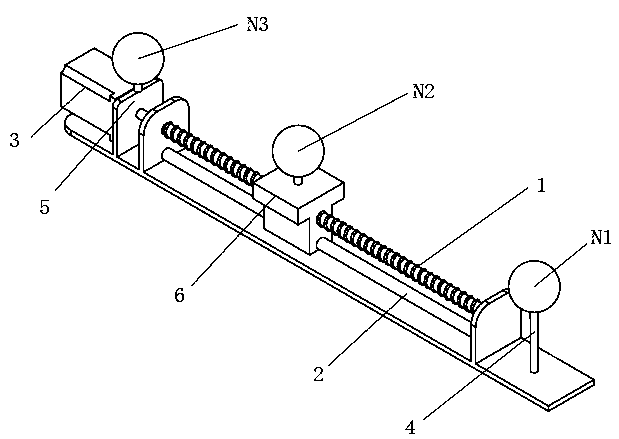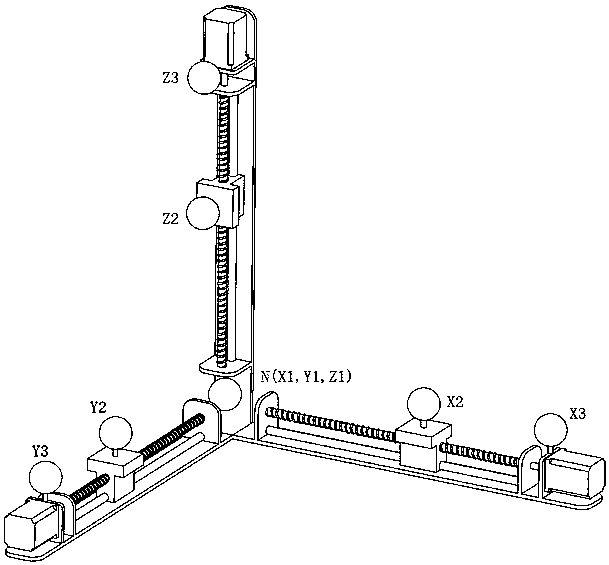Self-adaptive direction-finding antenna for measuring signal direction of mobile phone and measuring method thereof
A technology of self-adaptive measurement and mobile phone signal, applied to direction finders using radio waves, radio wave direction/deviation determination systems, antennas, etc. Universal requirements and other issues to achieve the effect of flexible adaptation
- Summary
- Abstract
- Description
- Claims
- Application Information
AI Technical Summary
Benefits of technology
Problems solved by technology
Method used
Image
Examples
Embodiment 1
[0043] Such as figure 1As shown, this embodiment proposes a single-dimensional adaptive direction-finding antenna for measuring the signal direction of a mobile phone, including three antenna units N1, N2, N3, a screw rod 1, a slide rail 2, a servo motor 3, and a first fixing seat 4 , the second fixed seat 5 and the sliding seat 6; the three antenna units N1, N2, and N3 are respectively fixed on the first fixed seat 4, the second fixed seat 5 and the sliding seat 6; the two fixed seats are respectively fixed on the slide rails 2, the screw rod 1 is parallel to the top of the slide rail 2, and the sliding seat 6 is provided with a slide rail sleeve hole and a threaded hole, which are respectively set on the slide rail 2 and the screw rod 1, and one end of the screw rod 1 is connected to the servo motor 3. The rotation is driven by the servo motor 3 to adjust the position of the sliding seat 6 . In this implementation solution, the distance between the direction finding antenna...
Embodiment 2
[0045] Such as figure 2 As shown, this embodiment proposes a three-dimensional adaptive direction-finding antenna for measuring the signal direction of a mobile phone, which is composed of three groups of single-dimensional adaptive direction-finding antennas in Embodiment 1. The antenna unit at the intersecting end of the direction-finding antenna is shared as a common reference antenna unit.
[0046] Specifically, the antenna units on the three groups of antennas are X1, X2, X3; Y1, Y2, Y3; Z1, Z2, Z3; where X1, Y1, and Z1 are shared, as a common reference antenna unit, set to N; X2 , Y2, and Z2 all perform single-dimensional sliding under the control of their respective servo motors to complete the variable distance operation in their respective dimensions; X3, Y3, and Z3 are fixed.
[0047] N point and X3 point, N point and Y3 point, N point and Z3 point have the same spacing, set as D3, select the maximum value according to the required size; N point and X2 point, N poi...
Embodiment 3
[0051] This embodiment introduces a method for determining the signal direction of a mobile phone with a three-dimensional adaptive direction-finding antenna, including steps:
[0052] S1. Set the frequency of the target source;
[0053] S2. The system control software automatically calculates D2 according to the frequency of the target source, the calculation formula D2 = C / (2*f), C is the propagation speed of electromagnetic waves in the atmosphere, and f is the center frequency of the target source;
[0054] S3. The system control software controls the servo motor to drive the screw to rotate so that the sliding seat moves to a position D2 away from point N;
[0055] S4. The system starts direction finding: on the X axis, measure the phase difference θ1 received by N and X2, and the phase difference θ2 received by N and X3; θ1 is a rough value, a unique value, and there is no multi-value; θ2 is an exact value, including multiple values;
[0056] S5. According to the calcu...
PUM
 Login to View More
Login to View More Abstract
Description
Claims
Application Information
 Login to View More
Login to View More - R&D
- Intellectual Property
- Life Sciences
- Materials
- Tech Scout
- Unparalleled Data Quality
- Higher Quality Content
- 60% Fewer Hallucinations
Browse by: Latest US Patents, China's latest patents, Technical Efficacy Thesaurus, Application Domain, Technology Topic, Popular Technical Reports.
© 2025 PatSnap. All rights reserved.Legal|Privacy policy|Modern Slavery Act Transparency Statement|Sitemap|About US| Contact US: help@patsnap.com


